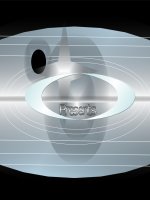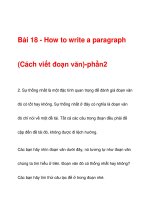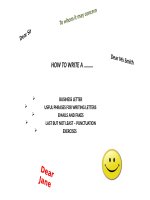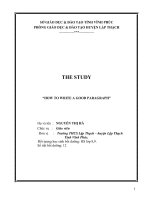HOW TO WRITE a PARAGRAPH
Bạn đang xem bản rút gọn của tài liệu. Xem và tải ngay bản đầy đủ của tài liệu tại đây (271.85 KB, 3 trang )
HOW TO WRITE A PARAGRAPH
CÁCH VIẾT MỘT ĐOẠN VĂN TIẾNG ANH
A. Đoạn văn ví dụ:
Topic: Why television is one of the most beneficial inventions of human?
(1) There are several reasons why television is one of the most beneficial inventions of human. (2) Firstly,
television helps us to learn more about the worldand to know and see many new things. (3) For
example, you can learn about various cultures around the world just by sitting on a couch. (4) Moreover,
television can make things memorable because it presents information in an effective way. (5) Secondly,
television entertains us as watching it is an enjoyable way to relax. (6) Music and film, for instance, are one
of the most frequently watched programs on TV. (7) Furthermore, it increases the popularity of sports and
games. (8) Finally, it makes us aware of our global responsibilities. (9) This can be seen in developed
and peaceful countries whose citizens become increasingly well-informed about the victims living under the
constant threat in warring nations. (10) Indeed, television has brought about many benefits because it is not
only a source of information and a means of entertainment but also a constant reminder of our duty to make
a better world.
Trả lời câu hỏi:
1. Đoạn văn trên có bao nhiêu phần chính? Mỗi phần gồm các câu nào?
2. Chức năng của từng phần trong đoạn văn trên là gì?
Trả lời: Đoạn văn trên gồm có 3 phần như sau:
a. Phần mở bài (còn gọi là câu chủ đề) : câu số (1) trong đoạn trên : "There are several reasons why
television is one of the most beneficial inventions of human."
- Nhiệm vụ của phần mở bài là giới thiệu chủ đề của bài paragraph mà chúng ta sắp viết.
- Trong phần mở bài, chúng ta thấy có 1 từ in đậm là từ several reasons. Trong viết đoạn văn thì ý này
được gọi là controlling idea (ý tưởng chủ đạo). Nhiệm vụ của nó là lật mở nội dung chủ đạo mà đoạn văn
của chúng ta sắp viết, đồng thời giới hạn những nội dung chính mà đoạn văn sắp đề cập.
b. Phần thân bài (supporting sentences): bao gồm câu số 2 đến câu 9 trong đoạn văn bên trên:
"(2) Firstly, television helps us to learn more about the worldand to know and see many new
things. (3) For example, you can learn about various cultures around the world just by sitting on a
couch. (4) Moreover, television can make things memorable because it presents information in an
effective way. (5) Secondly, television entertains us as watching it is an enjoyable way to relax. (6) Music
and film, for instance, are one of the most frequently watched programs on TV. (7) Furthermore, it increases
the popularity of sports and games. (8) Finally, it makes us aware of our global responsibilities. (9) This
can be seen in developed and peaceful countries whose citizens become increasingly well-informed about
the victims living under the constant threat in warring nations."
- Nhiệm vụ của phần thân bài là đưa ra và giải thích các ý kiến, lập luận chính đã được giới hạn ở câu mở
đầu.
-Trong đoạn văn trên thì ý chính của đoạn là ý ở các câu: 2, 5, 8. Chúng được gọi là supporting
sentences (các câu giải thích cho câu chủ đề)
- Các ý nêu ra trong câu 3, 4, 6, 7, 9 có nhiệm vụ giải thích, chứng minh cho các ý chính vừa nêu ở các câu
2,5,8. Chúng được gọi là supporting details.
- Các ý chính được nối với nhau bởi các liên từ như: Firstly; Secondly; moreover, ...finally. Nhờ vậy, đoạn
văn trở nên logic và mạch lạc hơn rất nhiều.
c. Kết bài: câu 10 trong đoạn trên: (10) Indeed, television has brought about many benefits because it is
not only a source of information and a means of entertainment but also a constant reminder of our duty to
make a better world.
- Nhiệm vụ của phần kết bài là nhắc lại ý chính đã nêu ở câu chủ đề bằng 1 cách viết khác, đưa ra kết luận
dựa trên các lập luận đã đưa ra trước đó.
B. CẤU TRÚC CỦA MỘT ĐOẠN VĂN
1. The topic sentence (câu chủ đề)
- Là câu đầu đoạn văn và cũng là câu quan trọng nhất trong đoạn.
- Câu này nêu vắn tắt nội dung mà đoạn văn sắp trình bày.
2. The controlling idea (Ý tưởng chủ đạo)
- Thường được đề cập trong câu chủ đề.
- Lật mở trọng tâm của cả đoạn văn.
- Giới hạn chủ đề của đoạn văn thành những vấn đề cụ thể.
3. The supporting sentences (các câu giải thích cho câu chủ đề)
- Đưa ra các ý chính để giải thích, chứng minh cho câu chủ đề.
CÁC TỪ NỐI CƠ BẢN TRONG ĐOẠN VĂN
1. Những từ dùng để thêm thông tin
11. Những từ chỉ dấu hiệu thời gian
• and (và)
∙ afterward (về sau)
• also (cũng)
∙ at the same time (cùng thời điểm)
• besides (ngoài ra)
∙ currently (hiện tại)
• first, second, third… (thứ nhất, thứ hai, thứ ba…)
∙ earlier (sớm hơn)
• in addition (thêm vào đó)
∙ formerly (trước đó)
• in the first place, in the second place, in the third ∙ immediately (ngay lập tức)
place (ở nơi thứ nhất, ở nơi thứ hai, ở nơi thứ ba)
∙ in the future (trong tương lai)
• furthermore (xa hơn nữa)
∙ in the meantime (trong khi chờ đợi)
• moreover (thêm vào đó)
∙ in the past (trong quá khứ)
• to begin with, next, finally (bắt đầu với, tiếp theo là, ∙ later (muộn hơn)
cuối cùng là)
∙ meanwhile (trong khi đó)
2. Những từ dấu hiệu chỉ nguyên nhân, hệ quả
∙ previously (trước đó)
• Accordingly (Theo như)
∙ simultaneously (đồng thời)
• and so (và vì thế)
∙ subsequently (sau đó)
• as a result (Kết quả là)
∙ then (sau đó)
• consequently (Do đó)
∙ until now (cho đến bây giờ)
• for this reason (Vì lý do này nên)
12. Showing examples (đưa ra ví dụ)
• hence, so, therefore, thus (Vì vậy)
– For example
• then (Sau đó)
– For instance
3. Những dấu hiệu chỉ sự so sánh
– Such as …
• by the same token (bằng những bằng chứng – To illustrate:
tương tự như thế)
Ex: To illustrate my point,…
• in like manner (theo cách tương tự)
13. Generalising (tổng quát, nói chung)
• in the same way (theo cách giống như thế)
– Generally,
• in similar fashion (theo cách tương tự thế)
– In general,
• likewise, similarly (tương tự thế)
– Generally speaking,
4. Những dấu hiệu chỉ sự đối lập
– Overall,
• but, yet (nhưng)
– On the whole,: On the whole,I think it is a good
• however, nevertheless (tuy nhiên)
idea but I would still like to study it further.
• in contrast, on the contrary (Đối lập với)
- All things considered,
• instead (Thay vì)
14. Specifying (nói chi tiết, cụ thể)
• on the other hand (Mặt khác)
– In particular,
• still (vẫn)
– Particularly,
5. Những từ dấu hiệu chỉ kết luận hoặc tổng kết. – Specifically,
• and so (và vì thế)
– To be more precise,
• after all (sau tất cả)
15. Expressing your opinion (nêu lên ý kiển của
• at last, finally (cuối cùng)
mình):
• in brief (nói chung)
– In my opinion,
• in closing (tóm lại là)
– Personally,
• in conclusion (kết luận lại thì)
– From my point of view,
• on the whole (nói chung)
– From my perspective,
• to conclude (để kết luận)
– It seems to me that…
• to summarize (Tóm lại)
– I believe that…
6. Từ dấu hiệu để chỉ ví dụ
– It appears to me that …
• as an example
16. Constrasting ideas (đưa ra ý kiến đối lập):
• for example
– However,
• for instance
– Nevertheless,
• specifically
– On the other hand,
• thus
– On the contrary,
• to illustrate
– Nonetheless,
7. Những từ dấu hiệu chỉ sự khẳng định
– Although……, …..
• in fact (thực tế là)
– ….while/whereas
• indeed (Thật sự là)
17. Comparing (so sánh):
• no (không)
– ….similar to…
• yes (có)
– Similarly,
• especially (đặc biệt là)
– In much the same way,
8. Những từ dấu hiệu chỉ địa điểm
– …as…as…
• above (phía trên)
18. Adding information (thêm vào ý kiến):
• alongside (dọc)
• beneath (ngay phía dưới)
• beyond (phía ngoài)
• farther along (xa hơn dọc theo…)
• in back (phía sau)
• in front (phía trước)
• nearby (gần)
• on top of (trên đỉnh của)
• to the left (về phía bên trái)
• to the right (về phía bên phải)
• under (phía dưới)
• upon (phía trên)
9. Những từ dấu hiệu chỉ sự nhắc lại
• in other words (nói cách khác)
• in short (nói ngắn gọn lại thì)
• in simpler terms (nói theo một cách đơn giản hơn)
• that is (đó là)
• to put it differently (nói khác đi thì)
• to repeat (để nhắc lại)
10. Những từ chỉ dấu hiệu thời gian
∙ afterward (về sau)
∙ at the same time (cùng thời điểm)
∙ currently (hiện tại)
∙ earlier (sớm hơn)
∙ formerly (trước đó)
∙ immediately (ngay lập tức)
∙ in the future (trong tương lai)
∙ in the meantime (trong khi chờ đợi)
∙ in the past (trong quá khứ)
∙ later (muộn hơn)
∙ meanwhile (trong khi đó)
∙ previously (trước đó)
∙ simultaneously (đồng thời)
∙ subsequently (sau đó)
∙ then (sau đó)
∙ until now (cho đến bây giờ)
23. Sequencing (thứ tự):
– First, Firstly, In the first place, First and foremost,
To begin/start with,…
– Secondly, Second,…
– Thirdly,..
– Finally, Lastly, Last but not least,…
– Moreover,
– Furthermore,
– In addition,
– Besides,
– What’s more,
– Apart from…,
– Also,
– Additionally,
19. Expressing certainty (thể hiện sự chắc chắn
về điều gì đó):
– Certainly,
– Undoubtedly,
– Obviously,
– It is obvious/clear that…
– Definitely
20. Expressing agreement (đưa ra sự đồng tình):
– …in agreement that…
– …in accordance with..
– Accordingly
21. Stating the reason why something
occurs/happens (đưa ra lí do, nguyên nhân):
– Due to…
– Owing to…
– This is due to …
– …because…
– …because of…
22. Stating the effect/result (đưa ra hậu quả, kết
quả):
– As a result,
– Therefore,
– Thus,
– For this reason,
– Consequently,
– As a consequence,
24. Concluding (kết luận):
– To conclude,
– In conclusion,
– To summarise,
– In summary,
– In short,
– To conclude with,
TOPICS :
1. What are the advantages/disadvantages of living in the big city?
2. What are the advantages/disadvantages of living in the countryside?
3. What are the advantages/disadvantages of wearing school uniforms?
4. What are the advantages/disadvantages of wearing casual clothes at school?
(Some high schools require all students to wear school uniforms. Other high schools permit students to
decide what to wear to school. Which of these two school policies do you think is better? Use specific
reasons and examples to support your opinion.)
5. What are the benefits of reading books?
6. What are the benefits of playing sports?
7. What are the benefits of doing exercises?
8. Should teachers give students much homework?
9. What are the advantages/disadvantages of studying online?
10. What are the advantages/disadvantages of the Internet?









